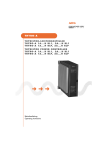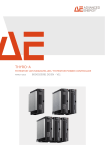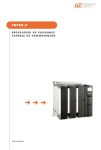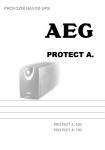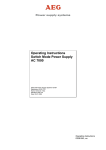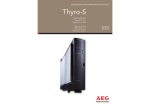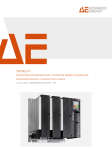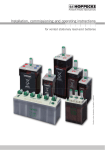Download AEG THYRO-A Operating instructions
Transcript
SVS POWER SUPPLY S THYRO-A THYRISTOR-LEISTUNGSSTELLER THYRO-A 1A...H1, 2A...H1 THYRISTOR POWER CONTROLLER THYRO-A 1A...H1, 2A...H1 Betriebsanleitung Operating Instructions Y S T E M S S A F E T Y I N S T R U C T I O N S The safety instructions and operating manual are to be carefully read prior to installation and commissioning Obligation to give instructions The following safety and operating instructions must be carefully read before initial assembly, installation and commissioning of Thyro-A by those persons working with or on Thyro-A. These operating instructions are part of the Power Controller Thyro-A. The operator of this device is obliged to provide, without restriction, these operating instructions to all persons transporting, commissioning, maintaining or performing other work on this device. In accordance with the Product Liability Act, the manufacturer of a product has an obligation to provide explanations and warnings as follows: • the use of the product other than for the intended use, • the residual product risk, • operating error and its consequences. The information given below must be understood in this respect. It is to warn the product user and protect him and his systems. Proper use • The Thyristor Power Controller is a component which may only be used for control and regulation of electrical energy. • The Thyristor Power Controller may at most be operated using the maximum admissible connected load according to information on the type plate. • The Thyristor Power Controller may only be operated in connection with a suitable and series connected power supply disconnecting device (e.g. switch, VDE 0150 T1). • As a component, the Thyristor Power Controller is unable to operate alone and must be projected for its intended use to minimize residual risks. 2 The Thyristor Power Controller may only be operated in the sense of its intended use; otherwise personal hazards, for (e.g. electric shocks, burns) and hazards for systems (e.g. system overload) may arise. Residual hazards of the product • Even in case of proper use, should a fault occur, it is possible that control of currents, voltages and power is no longer performed in the load circuit by the Thyristor Power Controller. In case of destruction of the power components (e.g. break-down or high resistance), the following situations are possible: power interruption, half-wave operation, continuous power flow. If such a situation occurs, then load voltages and currents are produced from the physical dimensions of the overall power circuit. It must be ensured by system design that no uncontrolled large currents, voltages or power occur. Maloperation and the results • With maloperation it is possible that power, voltage or flow levels which are higher than planned reach the Thyristor Power Controller or load. On principle, this can lead to the Power Controller or load being damaged. Transport • Thyristor Power Controllers are only to be transported in their original packaging (protection against damage e.g. due to jolting, knocking, soiling). Installation • If the Thyristor Power Controller is brought into the operation room from a cold environment, moisture can occur. Prior to it being commissioned, the Thyristor Power Controller must be absolutely dry. Therefore, wait for a minimum of two hours before commissioning. Connection • Prior to connection, it must be ensured that the voltage information on the type plate corresponds with the mains voltage. • The electrical connection is carried out at the designated points with the required cross section and the appropriate screw cross sections. 3 Operation • The Thyristor Power Controller may only be connected to the mains voltage if it has been ensured that any hazard to people and system, especially in the load section, has been eliminated. • Protect the device from dust and moisture • Do not block vents. Maintenance, service, malfunctions CAUTION For maintenance and repair work the Power Controller must be disconnected from all external voltage sources and protected against restarting. The voltage-free state is to be determined by means of suitable measuring instruments. This work is only to be carried out by a skilled electrician. The electrical regulations which are locally valid are to be adhered to. CAUTION The Thyristor Power Controller contains dangerous voltages. Repairs may only be carried out by qualified and trained maintenance personnel. CAUTION Danger of electric shocks. Even after disconnection from the mains voltage, capacitators may still contain a dangerously high power level. CAUTION Danger of electric shocks. Even when the Thyristor Power Controller is not triggered, the load circuit is not disconnected from the mains. ATTENTION Different components in the power section are screwed into place using exact torques. For safety reasons, power component repairs must be performed by AEG SVS Power Supply Systems GmbH. S A F E T Y 4 I N S T R U C T I O N S Contents ➜ ➜ ➜ Safety instructions 2 Safety regulations 8 Remarks on the present operating instructions and Thyro-A 11 ➜ 1. 1.1 1.2 1.3 1. Introduction General Specific characteristics Type designation 13 13 13 14 ➜ 2. 2.1 2.2 2.3 2.3.1 2.3.3 2.4 2.4.1 2.4.2 2.5 2.5.1 2.5.2 2.5.3 Functions Operating modes Set point control characteristic Control types Controlled value Controller response Indications LED indications Alarm relay K1 Monitoring Monitoring of load and mains voltage Absolute value monitoring current Ventilator monitoring 14 14 15 17 17 17 17 17 18 18 18 18 18 ➜ 3. 3.1 3.1.1 3.1.2 3.1.3 3.1.4 3.2 3.2.1 3.3 Operation Configuration switch S1 Operating mode Control types Live-zero set point Analog input Potentiometer R201 Phase angle 1. half wave operation TAKT Diagnosis / status indication 18 18 19 19 19 19 19 19 00 5 ➜ 4. 4.1 4.2 4.3 4.4 4.5 4.6 4.7 Phase angle 1 half wave operation TAKT Power supply for Thyro-A Power supply for the control device Impulse lock Analog output Digital set point value input Voltage transformer Operating elements and terminal strips 20 20 21 21 21 21 21 23 ➜ 5. Interfaces 24 ➜ 6. 6.1 6.2 6.3 Mains load optimization Synchronization SYT-9 (operating mode TAKT) Synchronization in operating mode QTM (1A) Software synchronization (operating mode TAKT) 24 25 25 25 ➜ 7. Connecting diagrams 26 ➜ 8. 8.1 8.2 8.3 8.4 Special remarks Installation Commissioning Service Checklist 29 29 29 30 31 ➜ 9. 9.1 9.2 Type overview Thyro-A 1A ... H 1 Thyro-A 2A ... H 1 31 32 32 ➜ 10. Technical data 33 ➜ 11. Dimensional drawings 35 ➜ 12. Accessories and options 41 ➜ 13. Approvals and conformities 41 Addresses 6 List of illustrations and tables Fig. Fig. Fig. Fig. Fig. Fig. Fig. Fig. Fig. 1 2 3 4 5 6 7 8 9 Control characteristic Set point inputs and total set point Set point inputs and total set point Terminal plan Operation Connecting diagram Thyro-A 1A...H1 Connecting diagram Thyro-A 2A...H1 Connecting diagram bus modul Connecting diagram mains load optimization with QTM 15 16 22 23 24 26 27 28 28 Tab. Tab. Tab. Tab. 1 2 4 5 Behaviour with load change Load monitoring Default values DIP switch S1 Default values potentiometer 17 20 29 30 7 ➜ Safety regulations Important instructions and explanations Operation and maintenance according to regulations, as well as observance of the listed safety regulations is required for the protection of the staff and to maintain readiness to operate. Personnel assembling/disassembling the devices, commissioning them, operating them and maintaining them must know and observe these safety regulations. In the present operating instructions important instructions are marked using the terms “CAUTION”, “ATTENTION” and “REMARK” as well as using the icons explained below. CAUTION This instruction indicates work and operating procedures to be observed exactly to exclude hazards to persons. ATTENTION This instruction refers to work and operating procedures to be observed exactly to avoid damage or destruction of Thyro-A or parts thereof. REMARK This is where remarks on technical requirements and additional information is given which the user must observe. Accident prevention rules It is imperative that the accident prevention rules of the country of application and the generally applicable safety regulations are observed. CAUTION Before starting any work on Thyro-A, the following safety regulations must be observed: • switch voltage-free • secure against switching on • determine voltage-free state • ground and short-circuit device • cover or block neighbouring parts under voltage. 8 Qualified personnel Thyro-A may only be transported, installed, connected, commissioned, maintained and operated by specialists in command of the respective applicable safety and installation regulations. All work must be monitored by the responsible specialist personnel. Intended use CAUTION The Thyristor Power Controller may only be employed in the sense of its purpose of use (see the section of the chapter Safety Instructions under the same name), otherwise hazards to persons (e.g. electric shocks, burns) and systems (e.g. overload) may occur. Any unauthorized reconstruction and modification of Thyro-A, use of spare and exchange parts not approved by AEG SVS as well as any other use of Thyro-A is not permitted. The person responsible for the system must ensure that: - safety and operating instructions are available and observed, - operating conditions and specifications are observed, - protective installations are used, - maintenance personnel are immediately notified or Thyro-A is immediately put out of commission if abnormal voltages or noises, higher temperatures, vibrations or similar occur to determine the causes. These operating instructions contain all information required by specialists for the use of Thyro-A. Additional information and notes for unqualified persons and for the use of Thyro-A outside of industrial installations are not contained in these operating instructions. The warranty obligation of the manufacturer applies only if these operating instructions are observed. 9 Warranty No liability is assumed when using Thyro-A for applications not provided for by the manufacturer. The responsibility for the necessary measures to avoid hazards to persons and property is borne by the operator or the user. In case of complaints on Thyro-A, please notify us immediately stating: Type name Production number Complaint Ambient conditions Operating mode Duration of use Guidelines The CE mark on the device confirms observation of the EC general guidelines for 72/23 EEC – low voltage and for 89/339 EEC electromagnetic compatibility if the instructions on installation and commissioning set out in the operating instructions are observed. 10 ➜ Remarks on the present operating instructions and Thyro-A Validity These operating instructions correspond to the technical state of Thyro-A at the time of publication. The contents are not subject matter of the contract, but serve only as information. Modification of information contained in these operating instructions, especially technical data, operation, dimensions and weights, remain reserved at any time. AEG SVS reserves the right to content modifications and technical changes within the present operating instructions without obligation to notification. AEG SVS is not obliged to update these operating instructions constantly. Handling These operating instructions for Thyro-A are set out so that all work required for commissioning, maintenance and repair may be performed by corresponding specialist personnel. Abbreviations In this description the following specific abbreviations are used: AEG SVS SYT TAKT VAR = = = = AEG SVS Power Supply Systems GmbH synchronized clock full wave switch mode Thyrotakt phase-angle mode Thyrovar Loss of warranty Our supplies and services are subject to the general terms and conditions of delivery of the electrical industry as well as our general sales conditions. Any complaints on goods delivered are to be submitted, together with the delivery note, within eight days of receipt. All guarantees made by AEG SVS and its dealers will be cancelled without prior notice if other than original AEG SVS spare parts or spare parts purchased by AEG SVS are used for maintenance and repair. 11 Copyright Passing on, duplication and/or takeover of these operating instructions by electronic or mechanical means, including excerpts, is subject to the express prior written approval of AEG SVS. Copyright AEG SVS Power Supply Systems GmbH 2002. All rights reserved. Additional remark on copyright Thyro- is an internationally registered trademark of AEG SVS Power Supply Systems GmbH. Windows and Windows NT are registered trademarks of the Microsoft Corporation. All other companies and product names are the (registered) trademarks of the respective owners. 12 ➜ 1. Introduction Thyro-A has been conceived to meet the demands for simple assembly, speedier commissioning and safer operation. For transport, assembly, installation, commissioning, operation and decommissioning, it is essential that the safety instructions included in these operating instructions are observed and made available to all persons handling this product. In case of uncertainties or missing information, please contact your supplier. The described operating mode QTM is being prepared. 1.1 General Thyro-A is a Thyristor Power Controller with the ability to communicate. It will also simply be referred to as Power Controller or Controller. It can be used wherever voltages or currents need to be controlled or regulated in processing technology. Thyro-A’s distinguishing features are its several operating and control modes, good coupling ability to process and automation technology, high control precision and simple handling through a 16-Bit processor. 1.2 Specific characteristics Thyro-A has a wide range of specific characteristics, for instance: ➜ easy handling ➜ type range 230-500 Volts, 8-280 A, single and double phase ➜ ohmic load and transformer load ➜ soft start function for transformer load ➜ control modes U, U2 ➜ operating modes TAKT, as well as VAR and QTM with Thyro-A 1A ➜ control with analog set points and / or via optional bus adapter ➜ series system interface ➜ electrical separation according to EN 50178 chapt. 3 Options: ➜ bus connections via bus adapter coupling to different bus systems, e.g. Profibus DP, Modbus RTU, other bus systems on request. 13 1.3 Type designation The type designation of the Thyristor Power Controllers is derived from the construction of its power section. Thyro-A 1A Power Controller with single phase power section suited for single phase loads Thyro-A 2A Power Controller with double phase power section suited for three phase operation in three phase saver circuit Example Thyro-A 1A Power Controller ...400...280 H F 1 with single phase power section with 400 Volt type voltage with 280 Amp type current with integrated semi-conductor fuse with ventilator (only 280 Amp types) designation Thyro-A, 2002 series The complete type range can be found in chapter 9, TYPE OVERVIEW. ➜ 2. Functions To enable Thyro-A to adjust optimally to the desired application, it is equipped with a wide range of functions. These are described below. Further functions are possible by applying Thyro-A within a bus system. See also chapter 5 INTERFACES. 2.1 Operating modes For adjustment to different electrical loads, the most favourable operating mode can be chosen. Full wave switch TAKT (for 1A, 2A) Depending on the prescribed set point, the mains voltage is periodically switched. In this operating mode almost no harmonics are created. Whole multiples of the mains periods are switched, thus avoiding d.c. components. The full wave switch mode is especially suited for loads with thermal inertia. Depending on the function angle 1. half wave, the phase frequency is adjusted independently to 5 or 50 mains periods = To. The phase operation creates minimal mains reactions. Should there be a flicker, this can be minimized with the aid of the mains load optimization. 14 Phase-angle principle VAR (for 1A)) Depending on the prescribed set point, the sine oscillation of the mains voltage is gated using a larger or smaller control angle . This operating mode is characterized by high control dynamics. With phase-angle control harmonics of the mains voltage occur. It is possible to compensate these by using circuit variants. Half-wave switch mode QTM (Quick-Takt-Mode for 1A) QTM is the patented fast operating mode which works on the half wave switch principle. Depending on the prescribed set point, mains half waves are switched. D.c. components are avoided for the phase duration. The fast phase control is particularly suited for IR beams as an alternative to phase-angle control. When using several controllers it is possible, by synchronisation, to keep the mains reactions small. 2.2 Set point control characteristic The set point control characteristic of Thyro-A can easily be adapted to the control output signal of an upstream process controller or automation system. All signals customary on the market may be used. The adaption is made by changing the starting and ending points of the control characteristic. If the controller is within a limit (Umax), both red LEDs blink alternatively in second intervals (chapt. 3.3). Fig. 1 Control characteristic analog input 15 Input set points The Power Controller Thyro-A is equipped with two input set points which are isolated from the mains. • Set point 1 • Set point 2 analog (X2.4 – X2.3 ground) system interface The analog input can be adapted to the various process controllers by means of the set point and live zero set point switches. The following signal ranges can be set: 0(4)-20mA (Ri = ca. 250), 0-5V (Ri = ca. 44k), 0-10V (Ri = ca. 88k). Within the stated input ranges these values with the control characteristic may be adjusted to any common signal characteristic. +5V supply voltage can be taken for a set point potentiometer from terminal X2.8 (5k RPoti 10k). The effective set point is the total set point. It is made by adding the two set points. It is either the analog set point or the bus set point. If the bus module is connected and in operation, the bus set point is effective. If the bus module or bus (e.g. Profibus-DP) is interrupted, the controller automatically switches to the analog set point. Fig. 2 Set point inputs and total set point 16 2.3 Control types Thyro-A …H 1 has two control types. Mains voltage variations and load changes are directly and quickly adjusted by bypassing the sluggish temperature control system. Before commissioning the Power Controller and selecting a control mode, familiarisation with the operating procedure and the effect upon the application is important. 2.3.1 Controlled value The controlled value effective on the load is proportionate to the total set point, depending on the control type. Control type U U2 Control value (proportionate to the total set point) output voltage, Urms output voltage, Urms2 2.3.2 Controller response If the load resistance changes, e.g. due to temperature effect, ageing or load fault, the values effective on the load change as follows: Underlying control limit Load resistance decreases ULoad P Load resistance increases ILoad P ULoad ILoad U Urms max larger = larger smaller = smaller U2 (UxU) Urms max larger = larger smaller = smaller Tab. 1 Behaviour with load change 2.4 Indications 2.4.1 LED indications The LEDs on the front signal the following states: • ON • PULSE INHIBIT green red operating indication, power supply controller device pulse lock active Blinking indications are described in chapter 3.3. 17 2.4.2 Alarm relay Unlike the types Thyro-A…H RL1, the Power Controllers of type Thyro-A…H1 have no alarm relay. 2.5 Monitoring Faults occurring in the Power Controller are signalled. Signalling ensues via red LED. 2.5.1 Monitoring of the load and mains voltage The limiting values of the voltage are -57% of the type voltage for undervoltage monitoring and +10% of the type voltage for overvoltage monitoring. This produces the following absolute limiting values: Type 230V 400V 500V Undervoltage 99V 172V 215V Overvoltage 253V 440V 550V 2.5.2 Equipment temperature monitoring The control board is equipped with a temperature monitor. In case of a fault the red LED blinks. 2.5.3 Ventilator monitoring The separately ventilated power controllers (…F…) are fitted with thermal monitoring. The temperature of the heat sink is measured. In case of a temperature overrange a fault indication ensues. ➜ 3. Operation This chapter describes the operating elements of Thyro-A. For default settings see chapter 8.2. 3.1 Configuration switch S1 A 8-pole DIP switch is situated at the front behind the hood. The individual switches are marked from 1–8 starting from the bottom and must be set before operation 18 according to application. They are only read in by the Power Controller once when switched on or with mains recovery. For safety reasons further operation is carried out with the hood closed. (3.2). 3.1.1 Operating mode S1- 1 0 1 0 1 2 0 0 1 1 Operating mode none TAKT - Operating mode VAR - phase-angle operation QTM - Quick takt operation 3.1.2 Control type S1- 3 0 1 4 0 0 5 0 0 Control type U2 (UxU) U (U) 3.1.3 Live zero set point S1- 3.1.4 S1- Signal level 0 - 20mA 4 - 20mA 6 0 1 Analogeingang 7 0 1 0 1 8 0 0 1 1 Signal levell 0 - 10V undefined 0 - 5V 0 - 20mA Eingangswiderstand 88k undefined 44k (e.g. for set point potentiometer) 250 3.2 Potentiometer R201 3.2.1 Phase angle 1. half wave (TAKT operation) Potentiometer R201 serves to set the transformer load. At works it is set at 60° el with Thyro-A 1A and at 90° el with Thyro-A 2A. Transformer loads with a nominal induction > 1.2 T, as well as wound core and toroidal core transformers optimization is necessary. With Thyro-A 1A generally 80°el turn (to the right), with Thyro-A 2A turn at smaller angles (to the left). An optimal setting is achieved when the rush current is minimal. 19 The soft start time SST is set at the same time. The also applies to the operating mode VAR. Depending on AN1 the soft start time has the following values: AN [1°el] 30 SST [ms] 0 33.7 =33.7 =41.2 =48.7 =56.2 =61.5 =64.5 =67.4 =70.5 =73.5 120 140 160 180 200 220 260 300 400 600 Rev. 7 7.5 8 9 10 11 12 12.5 13 13.5 14 With a solely ohmic resistance load the poti can be turned to the left limit stop, at 30°el Thyro-A independently switches to a faster pulse operation with To = 5 periods without SST. In this configuration the terminal X2.7 can be used as an additional digital “set point value” (24V d.c.). This also permits the controller to be driven by a 2-point controller. 3.3 Diagnosis / status indications Faults can occur in the load circuit and in the controller itself or from the mains. Diagnosis of unexpected operating behaviour is performed by LEDs on the front panel of the control device. Description Frequency fault LED’s PULSE INHIBIT blinks SYNC fault PULSE INHIBIT blinks Temperature monitoring red LED blinks Flash values invalid Correction values invalid Undervoltage Pulse lock active 2 red LEDs blink synchron PULSE INHIBIT PULSE INHIBIT U limitation 2 red LEDs blink slowly, alternatively Description Outside 47Hz to 63Hz when switching on or Zero crossing outside permissible tolerance range in operation Temp. monitoring responded (control board or control section) Mains fault Mains fault Bridge X2: 1.2 opened U limit value exceeded Tab. 2 Allocation of message register ➜ 4. External connections 4.1 Power supply for Thyro-A Connecting the power supply is carried out as shown in the figures and TECHNICAL DATA. With Thyro-A 2A a right rotational field in the power circuit is required. 20 4.2 Power supply for the control device The control device is supplied directly from the power section (terminals U1, X1:1.2). This voltage also serves as mains synchronization. The mains connection is equipped for input voltages of Unom – 15% to +10% and nominal frequencies of 47Hz to 63Hz. Both terminals (X1:1.2 1.5mm2 grid 3.81) are internally bridged. If a phase is connected to X1, a fused connection is necessary (figs. 3,7). 4.3 Pulse lock The pulse lock (PULSE INHIBIT; terminals X2.1 - X2.2 1.5mm2, grid 3.5) is activated by opening the pulse-lock bridge, i.e. the power section is no longer triggered. If the pulse lock is activated the LED “PULSE INHIBIT” lights up red. It is imperative to use the pulse lock with transformer load in order to activate the Soft Start function. It may only then be released when there is a voltage supply to the power section. With Thyro-A 2A the pulse lock is only wired to the master (L1, left). 4.4 Analog set point value input The set point value input (terminal X2: 3 ground - X2:4 + 1.5mm2 grid 3.5) is suitable for process controllers with output signals of 0(4) - 20mA, 0-5V, 0-10V. 4.5 Digital set point value input Under certain conditions terminal X2.7 can be used as additional digital “set point value input” (24V d.c.) so that, for instance, Thyro-A can be triggered by a 2-point regulator. Further information is available on this in chapter 3.2.1. 4.6 Voltage transformer The load voltage is recorded by the measuring signal given by the supply voltage. This value is linked with the control angle or the pulse ratio Urms = Umains * √ (TS/To). The voltage transformer only has local mode wiring. 21 System - Interface Fig. 3: Block connecting diagram The above block connection diagram shows the basic functions of Thyro-A...H1. 22 4.7 Operating elements and terminal strips This chapter describes all terminal strips and jumpers. Control ground Connection to slave with 2A Connection to slave with 2A Control ground RxD / connection to bus module TXD / connection to bus module Bus module recognition RM 3.5 Earth potential or if necessary screen trip line RM 3.5 + 5V output e.g. for a set value poti (5 k RPoti 10 k) Sync. In (SYT-9 / QTM, see also chapt. 4.4) Sync. Out (QTM) Control ground Analog set point input max. 10V, max. 20mA Control ground Pulse lock (PULSE INHIBIT) Control ground L2/N supply connection - synchr. voltage supply frequency RM 3.81 L2/N supply connection - synchr. voltage supply frequency RM 3.81 X 350 test jumper X 2 is not applicable with the slave components of Thyro-A 2A Fig. 4: Terminal plan 23 LED green ON LED red PULSE INHIBIT Set point value input Set point value input Live zero set point Control type Control type Control type Operation mode Operation mode Chap. 3.1.4 Phase angle Chap. 3.2.1 TRAFO ADAPTION Chap. 3.1.3 Chap. 3.1.2 Chap. 3.1.1 Fig. 5: Operation ➜ 5. Interfaces With its system interface terminal strip X22 the Power Controller Thyro-A can be connected via an optional bus module to, for example, Profibus DP or Modbus RTU (other bus modules available on request). Description and connections can be taken from the instructions of the respective components. REMARK The access to set value, actual values and parameters made possible through bus provides further useful functions for application, e.g. software synchronization. The corresponding operating instructions provide further information on this. ➜ 6. Mains load optimization Thyro-A can be operated in multiple controller applications with mains load optimization. The application of mains load optimization offers substantial advantages, e.g. reduction of mains load peaks and mains reactions. Mains load optimization is possible in multiple controller applications in which either the operating mode TAKT (slow pulse at AN_1 30°el) or operating mode QTM is applied. 24 6.1 Synchronization SYT-9 (operating mode TAKT) SYT-9 is a process for static load optimization. It minimizes main load peaks and associated mains reaction shares. Set points and load changes are not automatically included in mains load optimization. The SYT-9 process requires and additional component. It can also be employed in connection with AEG controllers already installed. Then the pulse must be connected to terminal X2.7 and the +5V for the SYT-9 card must be connected to X2.8. The operating mode TAKT contains a high pulse frequency (AN1 30°el for ohmic load, To = 5 supply periods) as well as a low pulse frequency (To = 50 supply periods). The low pulse frequency is also suitable for switching transformers and is activated independently at phase angle 30°el. Only in this operating mode is the input X2:7 scanned. Is a pulse recognised, impulse is switched on and the pulse time To applies from here. The impulse is switched by the Synchrotakt component via an optoelectronic coupler. Energy comes from its own controller (X2.8). Please observe the operating instructions of the SYT-9 component. 6.2 Synchronization in operating mode QTM (1A) In the operating mode QTM the synchronization of 2-12 controllers is possible. The operating mode QTM works in rapid half-wave frequency with a pattern of switched and locked half waves at particular intervals 1 sec, also designated as To. To achieve a balance in supply from the outset (not after To) the individual controllers synchronize themselves by staggering by one supply period. With the first connected controller the SYT input X2.7 is jumped to +5V X2.8. The following controllers receive their impulses at X2.7 from sync. output X2.6 of the previous controller. With the last controller X2.6 remains free (series connection). This synchronization method is only possible with Thyro-A 1A (see Fig. 9). . 6.3 Software synchronization (operating mode TAKT) The application of an optional bus module activates the software synchronization. 25 7. Connecting diagrams System - Interface ➜ Fig. 6: Connecting diagram Thyro-A 1A...H1 26 System - Interface Fig. 7: Connecting diagram Thyro-A 2A...H1 27 System - Interface Fig. 8 Connecting diagram bus modul Mains load optimization with QTM Fig. 9 Connecting diagram mains load optimization with QTM 28 ➜ 8. Special remarks 8.1 Installation Thyro-A requires a vertical fitting position. With cabinet mounting sufficient ventilation of the cabinet must be ensured. The distance between the Power Controller and the cabinet ceiling or other mountings should be at least 150mm. The distance below the Power Controller should be at least 100mm. Heating up of the device by heat sources must be avoided. The dissipation of the Power Controller is stated in the Type overview table. ATTENTION Grounding must be carried out according to local regulations! (grounding screw for protective conductor connection on fastening adapter). The grounding also serves EMV devices (Y capacitor 4.7 nF). For single-phase devices with type currents 8A, 16A or 30A an adapter can be delivered for the 35mm top-hat rail assembly. 8.2 Commissioning The device must be connected to the mains and the associated load according to the corresponding connecting plans. On delivery the device is parameterized and adjusted to the respective power section. The operating mode TAKT (S1-1, S1-2) for transformer load (R201) is set. If a different operating mode is desired, then it must be set by the user. The following table shows the default settings of the DIP switch. Setting act. Setting Chapter No. Analog input Default S1-8 Signal level S1-7 Life Zero S1-6 Control mode 0-20mA 3.1.4 0mA 3.1.3 U2 3.1.2 TAKT 3.1.1 S1-5 S1-4 Control mode S1-3 Operating mode S1-2 Operating mode S1-1 Tab. 4 Default values DIP switch S1 29 The default settings of the potentiometer can be taken from the following table. Phase angle 1. half wave R201 Default Setting act. Setting Thyro-A 1A: 60° el. Thyro-A 2A: 90° el. Chapter No. 3.2.1 Tab. 5 Default values potentiometer All standard settings should be checked by the user as a matter of course and adjusted to the operating conditions (e.g. operating mode, control mode, limits, monitoring, control characteristics, actual value output, fault indications etc.) REMARK Apart from the load and current supply to X1.1, certain control signals must be connected too. The following signals are essential for operating the device: Set point Pulse lock (terminal 4 or by system interface) (on ground, on terminal 1,2; jumper) If the pulse lock jumper is not connected, the device is in a locked state and will not operate. Communication via interface is still possible. Further details on the pulse lock are described in the chapter of the same name. ATTENTION Heat sinks and neighbouring plastic parts are hot during operation ( 70°C)! Provided sign should be fixed nearby Thyro-A. 8.3 Service The devices delivered have been produced under quality standard ISO 9001. Should nevertheless faults or problems occur, our 24-hour service hotline: Tel: 02902 / 763-100. is at your service. 30 8.4 Checklist • LED ON green does not light up - Check fuse control 500V 1.6 A, if defective check external wiring, also applies to faults of external fusing. - Check Power Controller fusing. If fuse is defect then check load and wiring to load. Synchronization voltage is supplied to X1.1. - With transformer load, check phase angle 1 (TRAFO ADAPTION) - fuse release caused by rush current is possible if setting is incorrect. - Check 5 Volt to X2.8. If this voltage is absent or too low, there is a defective component. • Supply available but no load current - Check that pulse lock is cleared (jumpered) terminal X2.1,2 - Check set point - Check for load interruption - Check blinking LED indications (chapt. 3.3) • Load current does not have expected value - Check set point Terminal X2.4 against X2.3 ground or Bus set point (with optional bus module) - Set point/controller value, max. value correctly parameterized - Check all parallel load resistances for current conduction - Check control end for correct setting - Check control characteristic adjustment (U, live zero) • Load current flows uncontrolled - In rare cases a Thyristor short-circuit can occur. ➜ 9. Type overview The type key comprises from left to right: Type range Thyro-A Number of controlled phases 1A, 2A Mains supply voltage 230, 400, 500 (V) Type current 30 ... 280 (A) and designation H(F) 1 for integrated semiconductor (H), with increased ventilation (F) and characteristic 1 for “series 2002”. 31 9.1 Thyro-A 1A...H 1 Thyristor controller with incorporated semiconductor, system bus interface, synchronization option (for TAKT: with integrated SYT9, for QTM), with operating modes TAKT, VAR, QUICK-TAKT-MODE (T-V-Q) and the control types U, U2 Type capacity [kW] Type Current 230V 400V 500V [A] 1A H1 H1 H1 H1 H1 H1 H1 H1 HF 1 8 16 30 45 60 100 130 170 280 9.2 Thyro-A 1.8 3.7 6.9 10 14 23 30 39 64 3.2 6.4 12 18 24 40 52 68 112 4 8 15 22.5 30 50 65 85 140 Dissipation [W] 30 47 48 80 105 150 210 330 Dimens. in mm / kg W H D Weight Dim. draw. 40 45 45 52 52 75 125 125 125 121 121 121 190 190 190 320 320 370 127 127 127 182 182 190 237 237 237 0.5 0.7 0.7 1.7 1.7 1.9 4 4 5 910 911 911 943 943 944 946 946 948 Current transf. Fuse F1 40 40 100 100 100 150 200 300 12 20 40 63 100 180 200 315 350 2A...H 1 Thyristor controller with incorporated semiconductor, system bus interface, synchronization option (with SYT9). Suitable for 3-phase operation in 3-phase economy circuit with operating mode TAKT and the control types U, U2 Type Current [A] 2A H1 H1 H1 H1 H1 H1 H1 H1 HF 1 32 8 16 30 45 60 100 130 170 280 Type capacity [kW] 400V 500V 5.5 11 21 31 42 69 90 118 194 7 14 26 39 52 87 112 147 242 Dissipation [W] 60 94 96 160 210 300 420 660 Dimens. in mm / kg W H D Weight Dim. draw. 80 90 90 104 104 150 250 250 250 121 121 121 190 190 190 320 320 393 127 127 127 182 182 190 237 237 237 1.4 1.4 3.4 3.4 3.8 8 8 11 000 001 001 003 003 004 006 006 008 Current transf. Fuse F1 40 40 100 100 100 150 200 300 12 20 40 63 100 180 200 315 350 ➜ 10. Technical data Type voltage Mains frequency Load description 230 Volt -57% +10% 400 Volt -57% +10% 500 Volt -57% +10% all models 47Hz to 63Hz; f=6 Hz; max. frequency change 5% per half wave ohmic load transformer load ATTENTION The induction of the load side transformer should not exceed 1.45T in case of mains overvoltage when using grain-oriented, cold-rolled plates = 1.2T nominal induction. Operating modes TAKT = VAR = QTM = full wave pulse = default setting (T0: 0.1 sec / 1.0 sec) phase-angle control (only Thyro-A 1A) fast half wave pulse (only Thyro-A 1A) Set point inputs The Power Controller Thyro-A has 2 set point inputs. The set point inputs are safely disconnected from the mains (SELV, PELV). Set point 1: External set point input signal ranges: 0(4)-20 mA Ri = ca. 250 0-5 V Ri = ca. 44 k 0-10 V Ri = ca. 88 k Set point 2: System interface, connection from superset PC or automation system Control characteristic The control characteristic is established by the maximum value of the dimensions to be controlled and the key values of the set point. Using these key values, the linear control characteristic may be set as desired. Each controller (e.g. temperature controller) whose output signal lies within the range 0-20mA / 0-5 V / 0-10 V, can easily be adapted to the Power Controller. Control types Voltage control Urms, Urms2 (default setting) 33 Precision of control In all ranges better than ±2.5% and ±2 digits with reference to the end value. Ambient temperature 35°C external cooling (F model with integrated ventilator) 45°C self air cooling At higher temperatures it is possible to operate with reduced type current: Temperature range up to 55°C: type current –2% /°C Power connections Type current Connector U1, U2 8A 16 A 30 A 45 A 60 A 100 A 130 A 170 A 280 A With UL Earthing screw Screw plug-in terminal Bracket / M4 Bracket / M4 Bracket / M4 Bracket / M4 Bracket / M4 M6 M6 M6 M6 M6 M6 M8 M 10 M8 M 10 M 10 M 10 applications only use 60°/75° copper conductors! Torques for screw connectors [Nm] Screw Min Rated M2 0.22 0.25 M4 0.85 1.3 M6 2.95 4.4 M8 11.5 17 M10 22 33 Conductor cross sect. 4 mm2, max. 6 mm2, max. 6 mm2, max. 50 mm2, max. 50 mm2, max. 50 mm2, max. 95 / 120 mm2 95 / 120 mm2 150 / 185 mm2 Max 0.28 (Phönix terminals) 1.7 5.9 22.5 44 Ventilation data 230V, 50-60Hz Thyro-A Type current 50 Hz Type current 60 Hz 1A 280 F 0.13 A 0.13 A 2A 280 F 0.25 A 0.26 A The ventilators must run with Thyro-A switched on, connection to X7 34 Air volume 120 m3/h 200 m3/h ➜ Size 0 11. Dimensional drawings 8A Dimensional drawing 910 Size 1 16A, 30A Dimensional drawing 911 35 Size 2 45A , 60A Dimensional drawing 943 Size 3 100A Dimensional drawing 944 36 Size 4 130A, 170A Dimensional drawing 946 Size 4 280A Dimensional drawing 948 37 Size 0 8A Dimensional drawing 000 Size 1 16 / 30A Dimensional drawing 001 38 Size 2 45A, 60A Dimensional drawing 003 Size 3 100A Dimensional drawing 004 39 Size 4 130 / 170A Dimensional drawing 006 Size 4 280A Dimensional drawing 008 40 ➜ 12. Accessories and options Order no. 8000 006 757 Support for 35 mm snap-on assembly for 8A,16A and 30A Order no. 2000 000 841 Busmodul Profibus DP Order no. 2000 000 842 Busmodul Modbus RTU ➜ 13. Approvals and conformities The following approvals and conformities are available for Thyro-A • Quality standard according to DIN EN ISO 9001 • UL registration, file no. E 135074, under preparation, with consideration to Canadian National Standard, project no. 02ME08043 • CE conformity • Low voltage directive 73/23 EEC • EMV directive 89/336 EEC; 92/31 EEC • Marking directive 93/68 EEC There is no product norm for Thyristor Power Controllers so that a sensible norm structure must be set up which ensures safe application and opportunity for comparison. CAUTION Thyristor Power Controllers are not devices for disconnection in the sense of DIN VDE 0105 T1 and may therefore be operated only in connection with a suitable mains isolating device (e.g. switch, isolating link). Further norms are adhered to, e.g. voltage dips according to 61000-4-11:8.94 are ignored by the control device or registered by triggering off monitoring. Generally an automatic start is made after the mains returns within the tolerances. In detail Conditions for use Built-in unit (VDE 0160) General requirements Design, vertical installation Operating conditions Operating location, industry sector DIN EN 50 178 DIN EN 60146-1-1:12.97 DIN EN 60 146-1-1; K. 2.5 CISPR 6 41 Temperature behaviour Storage temperature D Transport temperature E Operating temperature better B Load class Humidity class Overvoltage category Degree of pollution Air pressure Protection class Safe isolation Up to 500 V mains voltage Air and creeping distances Mechanical impact Test voltage Tests according to EMV noise emission Noise suppr. control device EMV noise resistance Compatibility level ESD Electromagnetic fields Burst mains lines control lines Surge mains lines control lines Line-conducted 42 1 B III 2 I Class A DIN EN 60 146-1-1; K 2.2 -25°C - +55°C -25°C - +70°C -10°C - +35°C with external cooling (280A) -10°C - +45°C for self air cooling -10°C - +55°C with reduced type current -2%/°C DIN EN 60 146-1-1 T.2 DIN EN 50 178 Tab. 7 (EN 60 721) DIN EN 50 178 Tab. 3 (849V) DIN EN 50 178 Tab. 2 900 mbar * 1000m above NN DIN EN 50178 Chap. 3 DIN EN 50 178 Chap. 3 casing / mains potential 5.5 mm casing / control potential 2.5 mm mains voltage /contr. potent. 10 mm mains volt. interactive 2.5 mm DIN EN 50 178 Chap. 6.2.1 DIN EN 50 178 Tab. 18 DIN EN 60 146-1-1 4. EN 61000-6-4 DIN EN 55011:3.91 CISPR 11 EN 61000-6-2 EN 61000-2-4:7.95 EN 61000-4-2:3.96 EN 61000-4-3:3.95 EN 61000-4-4:.95 Class 3 8 kV (A) 10 V/m 2 kV (A) 2 kV (A) 2 kV unsym. EN 61000-4-5:.95 1 kV sym. EN 61000-4-5:.95 0.5 kV EN 61000-4-6 Weltweit ist AEG SVS auf allen wichtigen Märkten durch Vertriebspartner vertreten. Die aktuellen regionalen Adressen finden Sie im Internet: http://www.aegsvs.de You can find the current adresses on the Internet: http://www.aegsvs.de AEG SVS Power Supply Systems GmbH A company of Saft Power Systems Emil-Siepmann-Straße 32 D-59 581 Warstein-Belecke Tel. +49 (0 ) 29 02 / 7 63 - 5 09 Printed in Germany · Änderungen vorbehalten · Druckerei Hecker, Inh. Andrea Koerdt · Brilon AEG SVS is represented by sales partners in all important markets world wide. Fax +49 (0 ) 29 02 / 7 63 - 12 01 D 8000008800 http://www.aegsvs.de 08/2002 Phone +49 (0 ) 29 02 / 7 63 - 2 78 http://www.saftpowersystems.com











































